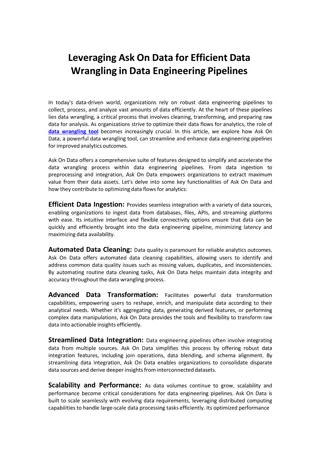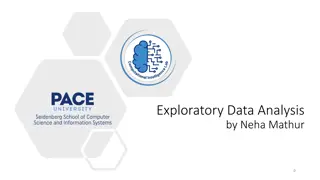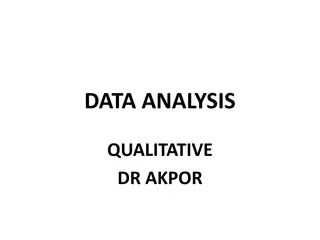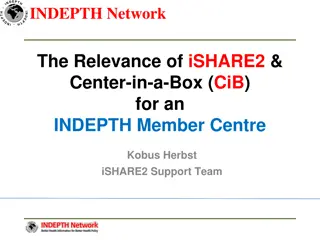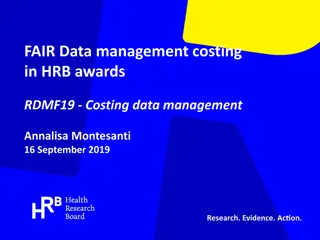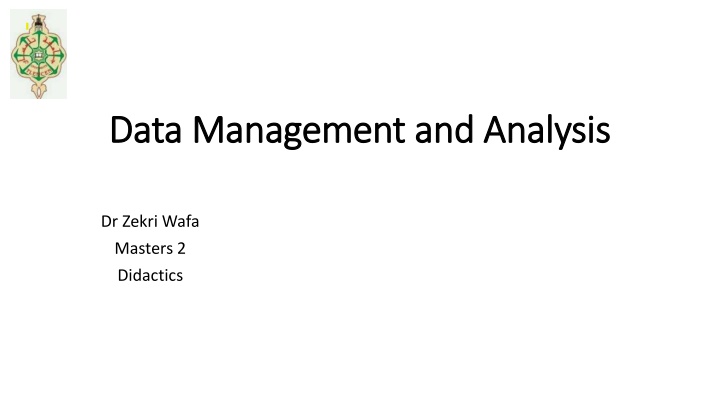
Effective Data Management and Analysis Strategies for Research Success
Explore key concepts in data management and analysis, including single-level and multi-level organization, digitizing and storing data, pre-analysis cleaning, and memoing techniques. Learn how to develop a robust data management plan and differentiate between data management and analyses.
Download Presentation

Please find below an Image/Link to download the presentation.
The content on the website is provided AS IS for your information and personal use only. It may not be sold, licensed, or shared on other websites without obtaining consent from the author. If you encounter any issues during the download, it is possible that the publisher has removed the file from their server.
You are allowed to download the files provided on this website for personal or commercial use, subject to the condition that they are used lawfully. All files are the property of their respective owners.
The content on the website is provided AS IS for your information and personal use only. It may not be sold, licensed, or shared on other websites without obtaining consent from the author.
E N D
Presentation Transcript
Data Management and Analysis Data Management and Analysis Dr Zekri Wafa Masters 2 Didactics
Whats your data management plan? What s your data management plan? How management differ from analyses? Consider research design: Qualitative Design 1. Phenomenological and IPA 2. Narrative 3. Ethnographic 4. Case study 5. Grounded theory 6. Digitizing data
What is Single What is Single- -level organisation? level organisation? You have 12 participants that you conducted interviews with them. Your single-level organisation is based on a collective representation of the data gathered. Your organisation of the data from 12 participants can be presented in one file, as it will appear in your texts: the common points between them, and differences. Representation of the data is based on the 12 participants.
Multi Multi- -level organisation level organisation If you have conducted interviews with 12 participants, but as round- up interviews, i.e., one participant is interviewed more than once. Your participants in this sense are received as cases Case 1 is participant 1 in your data chapter, Transcribe interview 1, then transcribe interview 2 Analyse both interviews to generate codes preliminary key words that are replicated. Generate themes from all interviews. Case 2: participant 1: interview 2, interview 3 Case 3: same process
Data Digitizing+ storing data Data Digitizing+ storing data Decisions 1. what do you need to digitize? 2. Where will you store/back-up the data? (cloud, USB, or external drive) make sure they are secure. 3. How will you maximise security and confidentiality of files?
Pre Pre- -analysis: cleaning data & analysis: cleaning data & Memoing Memoing Reading and rereading the data. Checking accuracy (listen/read the data) check spelling, do it immediately after data collection session (you are fresh with it) Identify vague words, and emojis, and body language you noted (recall how did you perceive them during the interview)
Memoing Memoing 1. Write down your initial thoughts and impressions of the data. 2. Write your reflexive thoughts (how does data relate to me as a researcher, individual, put yourself in the participant s shoes: Think of your positionality in the research: 3. Do you agree with the data? 4. What are the common ideas that represent your experiences, attitudes, and emotions.
Example of Data Cleaning Example of Data Cleaning Your participant mentioned during the interview It . Write it into a clear subject/noun to clarify what the interviewee meant. You don t have to exclude it from the data transcription, rather put between brackets what it refers to. Example; Interviewee: it can be debatable , during the interview, you know your topic, and what the interviewee is explaining, It (culture) means many things, and it s difficult to teach it to EFL learners. This example is a way to check accuracy and present clear meaning to your reader.
Whats Qualitative Data Analysis? What s Qualitative Data Analysis? It s messy! Too many texts Strategic: inductive vs deductive processes Detailed examination of the data Micro level (units of data or text arguments): segments of data Macro (holistic): Saldana talked about it, narrative research, we look at the story. Methodology logical and systematic
Interpretation is Making Meaning Interpretation is Making Meaning Making intentional decisions, write what you understood based on what participants reported and how this was justified in the literature review. Memoing (use your primary impressions of the data) Base your analyse on a specific framework of analysis: In qualitative research, content or thematic approaches are often analysed using specific models such as: Saldana, and Braun and clarck for thematic analysis (this is not required in your MA, but you can learn it) Check: Coding qualitative data using thematic/content analysis
Thematic analysis/ Grounded Theory Thematic analysis/ Grounded Theory 1. First round of analysis: Read initial ideas/analysis/ define labelling (coding) Inductive analysis: becoming familiar with the data; identify segments of the data; assign meaning to segments of the data. Use colours to highlight words that have similar meaning, and which are related to your research questions.
Deductive Analysis Deductive Analysis Identify relevant segments of data (from literature, previous works) To start from top-down Use pre-existing categories How does your data relate to the pre-existing categories/ themes
Inductive analysis Inductive analysis Bottom-up Identify codes Group data Less prone to bias You label according To your understanding
Coding in Coding in Thematic analysis Thematic analysis
Interview coding Interview coding Coding - Research Journal (weebly.com)
Quantitative data Quantitative data
Theses demonstrations & Discussions Theses demonstrations & Discussions Observation Analysis How is the data presented? How many sessions are presented? How are they presented? (thematic or in a descriptive approach) Survey Analysis How is the data presented? How many sessions are presented? How are they presented? (thematic or in a descriptive approach)
Interview Analysis How is the data presented? How many sessions are presented? How are they presented? (thematic or in a descriptive approach)
Questions? Thank you


